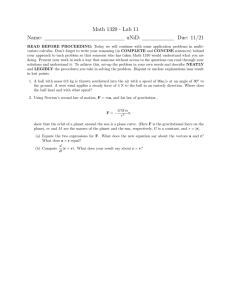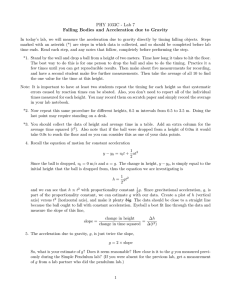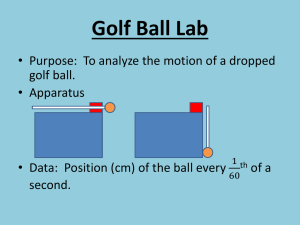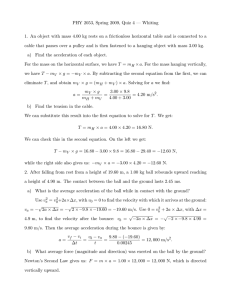Name: _____________________________ AP C: SHM Problems
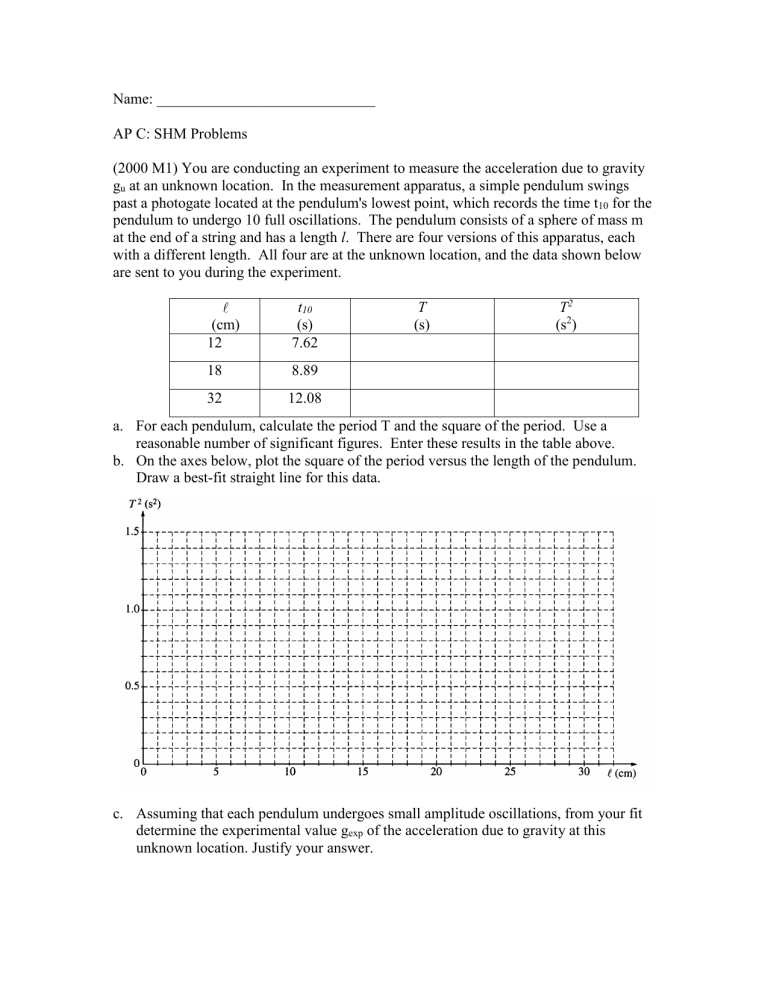
Name: _____________________________
AP C: SHM Problems
(2000 M1) You are conducting an experiment to measure the acceleration due to gravity g u
at an unknown location. In the measurement apparatus, a simple pendulum swings past a photogate located at the pendulum's lowest point, which records the time t
10
for the pendulum to undergo 10 full oscillations. The pendulum consists of a sphere of mass m at the end of a string and has a length l . There are four versions of this apparatus, each with a different length. All four are at the unknown location, and the data shown below are sent to you during the experiment.
(cm) t
10
(s)
12 7.62
T
(s)
T
(s
2
2
)
18
32
8.89
12.08 a. For each pendulum, calculate the period T and the square of the period. Use a reasonable number of significant figures. Enter these results in the table above. b. On the axes below, plot the square of the period versus the length of the pendulum.
Draw a best-fit straight line for this data. c. Assuming that each pendulum undergoes small amplitude oscillations, from your fit determine the experimental value g exp
of the acceleration due to gravity at this unknown location. Justify your answer.
d. If the measurement apparatus allows a determination of g u
that is accurate to within
4%, is your experimental value in agreement with the value 9.80 m/s
2
? Justify your answer. e. Someone informs you that the experimental apparatus is in fact near Earth's surface, but that the experiment has been conducted inside an elevator with a constant acceleration a . Assuming that your experimental value g is exact, determine the magnitude and direction of the elevator's acceleration.
1999 M2 A spherical, nonrotating planet has a radius R and a uniform density
throughout its volume.
Suppose a narrow tunnel were drilled through the planet along one of its diameters, as shown in the figure above, in which a small ball of mass m could move freely under the influence of gravity. Let r be the distance of the ball from the center of the planet. a. Show that the magnitude of the force on the ball at a distance r < R from the center of the planet is given by F = -Cr. where C = 4/3(
G
m). b. On the axes below, sketch the force F on the ball as a function of distance r from the center of the planet.
The ball is dropped into the tunnel from rest at point P at the planet's surface. c. Determine the work done by gravity as the ball moves from the surface to the center of the planet. d. Determine the speed of the ball when it reaches the center of the planet. e. Fully describe the subsequent motion of the ball from the time it reaches the center of the planet. f. Write an equation that could be used to calculate the time it takes the ball to move from point P to the center of the planet. It is not necessary to solve this equation.
1996M1. A thin, flexible metal plate attached at one end to a platform, as shown above, can be used to measure mass. When the free end of the plate is pulled down and released, it vibrates in simple harmonic motion with a period that depends on the mass attached to the plate. To calibrate the force constant, objects of known mass are attached to the plate and the plate is vibrated, obtaining the data shown below. a. Fill in the blanks in the data table. b. On the graph below, plot T 2 versus mass. Draw on the graph the line that is your estimate of the best straight-line fit to the data points. c. An object whose mass is not known is vibrated on the plate, and the average time for ten vibrations is measured to be 16.1 s. From your graph, determine the mass of the object. Write your answer with a reasonable number of significant digits. d. Explain how one could determine the force constant of the metal plate.
e. Can this device be used to measure mass aboard the space shuttle Columbia as it orbits the Earth?
Explain briefly. f. If Columbia is orbiting at 0.3 x 10 6 m above the Earth's surface, what is the acceleration of Columbia due to the Earth's gravity? (Radius of Earth = 6.4 x 10 6 m, mass of Earth = 6.0 x 10 24 kg) g. Since the answer to part (f) is not zero, briefly explain why objects aboard the orbiting Columbia seem weightless.
1990M3. A 5-kilogram block is fastened to a vertical spring that has a spring constant of 1,000 newtons per meter. A 3-kilogram block rests on top of the 5-kilogram block, as shown above. a. When the blocks are at rest, how much is the spring compressed from its original length?
The blocks are now pushed down and released so that they oscillate. b. Determine the frequency of this oscillation. c. Determine the magnitude of the maximum acceleration that the blocks can attain and still remain in contact at all times. d. How far can the spring be compressed beyond the compression in part (a) without causing the blocks to exceed the acceleration value in part (c) ? e. Determine the maximum speed of the blocks if the spring is compressed the distance found in part (d).
1989M3. A 2-kilogram block is dropped from a height of 0.45 meter above an uncompressed spring, as shown above. The spring has an elastic constant of 200 newtons per meter and negligible mass. The block strikes the end of the spring and sticks to it. a. Determine the speed of the block at the instant it hits the end of the spring. b. Determine the period of the simple harmonic motion that ensues. c. Determine the distance that the spring is compressed at the instant the speed of the block is maximum. d. Determine the maximum compression of the spring. e. Determine the amplitude of the simple harmonic motion.
1980M1. A small mass m
1
rests on but is not attached to a large mass M
2
that slides on its base without friction.
The maximum frictional force between m
1
and M
2
is f. A spring of spring constant k is attached to the large mass M
2
and to the wall as shown above. a. Determine the maximum horizontal acceleration that M
2
may have without causing m
1
to slip. b. Determine the maximum amplitude A for simple harmonic motion of the two masses if they are to move together, i.e., m
1
must not slip on M
2
. c. The two-mass combination is pulled to the right the maximum amplitude A found in part (b) and released.
Describe the frictional force on the small mass m
1
during the first half cycle of oscillation. d. The two-mass combination is now pulled to the right a distance of A' greater than A and released. i. Determine the acceleration of m
1
at the instant the masses are released. ii. Determine the acceleration of M
2
at the instant the masses are released.
